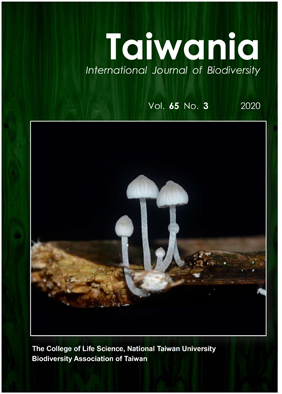Research Paper
Aster kanoi (Asteraceae, Astereae), a new species from Taiwan, with lectotypification and morphological emendation of Aster takasagomontanus
Shih-Wen Chuang, Wei-Jie Huang, Tian-Chuan Hsu
Published on: 12 June 2020
Page: 315 - 320
DOI: 10.6165/tai.2020.65.315
Abstract
Aster kanoi S. W. Chung, W. J. Huang & T. C. Hsu (Asteraceae, Astereae), a new species from Taiwan, is described and illustrated. A. kanoi is morphologically similar to A. takasagomontanus Sasaki but can be distinguished by its slenderer rhizome, up to 7-headed corymbiform synflorescence, smaller capitulum and fimbriate-ciliate margin of phyllary. A lectotype of A. takasagomontanus is also designated due to the absence of the original holotype, and its morphological delimitation is reappraised.
Keyword: Asterinae, Alpine, Endemic, Kano Tadao, Lectotypification
Literature Cited
Chen, Y.-L., L. Brouillet and J. C. Semple 2011. Aster. In: Wu, Z.-Y. & P. H. Raven (Eds.) Flora of China, vol. 20. Science Press, Beijing & Missouri Botanical Garden Press, St. Louis, pp. 574–632.
Dorn, R. 2003. Asters retreat to Eurasia. Castilleja 22:3.
Editorial Committee of the Red List of Taiwan Plants. 2017. The Red List of Vascular Plants of Taiwan, 2017. Endemic Species Research Institute, Forestry Bureau, Council of Agriculture, Executive Yuan and Taiwan Society of Plant Systematics, Nantou. 187 pp.
Ito, M., A. Soejima, M. Hasebe and K. Watanabe. 1995. A chloroplast-DNA phylogeny of Kalimeris and Aster, with reference to generic circumscription. J. Plant. Res. 108: 93–96.
IUCN. 2012. IUCN Red List Categories and Criteria: Version 3.1. IUCN, Gland, Switzerland and Cambridge, UK.
Korolyuk, E., A. Makunin, and T. Matveeva. 2015. Relationships and generic delimitation of Eurasian genera of the subtribe Asterinae (Astereae, Asteraceae) using molecular phylogeny of ITS. Turk. J. Bot. 39(5): 808–824.
DOI: 10.3906/bot-1410-12View Article
Google Scholar
Li, W.-P. and S.-X. Liu. 2002. Aster jishouensis (Asteraceae), a new species from Hunan, China. Acta Phytotax. Sin. 40: 455– 457.
Li, W.-P. and G.-X. Chen. 2006. Aster ageratoides var. pendulus W. P. Li & G. X. Chen, a new variety of Aster (Asteraceae) from Hunan, China. Acta Phytotax. Sin. 43(3): 348–350.
DOI: 10.1360/aps050051View Article
Google Scholar
Li, W.-P., F.-S. Yang, T. Jivkova and G.-S Yin. 2012. Phylogenetic relationships and generic delimitation of Eurasian Aster (Asteraceae: Astereae) inferred from ITS, ETS and trnL-F sequence data. Ann. Bot. 109(7): 1341–1357.
DOI: 10.1093/aob/mcs054View Article
Google Scholar
Li, Z., G.-S. Yin, M. Tang, and W.-P. Li. 2017. Aster oliganthus (Asteraceae, Astereae), a new species from western Sichuan, China, based on morphological and molecular data. Phytotaxa 326(1): 54–62.
DOI: 10.11646/phytotaxa.326.1.4View Article
Google Scholar
Ling, R., Y.-L. Chen and Z. Shi. 1985. Astereae. In: Ling R., Y.-L. Chen and Z. Shi (Eds.) Flora Reipublicae Popularis Sinicae. Science Press, Beijing, pp. 70–353.
Mabberley, D.J. 2017. Mabberley’s Plant-Book: A portable dictionary of plants, their classification and uses. Fourth Edition. Cambridge University Press, Cambridge.
DOI: 10.1017/9781316335581.003View Article
Google Scholar
Nesom, G. L. 1994. Review of the taxonomy of Aster sensu lato (Asteraceae: Astereae), emphasizing the New World species. Phytologia 77(3): 141–297.
Noyes, R. D. and L. H. Rieseberg. 1999. ITS sequence data support a single origin for North American Astereae (Asteraceae) and reflect deep geographic divisions in Aster s.l. Am. J. Bot. 86(3):398–412.
DOI: 10.2307/2656761View Article
Google Scholar
Sasaki, S. 1931. Miscellaneous Contributions to the Flora of Formosa (IX). Trans. Nat. Hist. Soc. Formosa 21: 151.
Soejima, A. and C.-I Peng. 2003 Aster. In: T.-C. Huang et al. (Eds.) Flora of Taiwan, 2nd ed. vol. 4. Editorial Committee of the flora of Taiwan. Department of Botany, National Taiwan University, Taipei. pp. 848–886
Turland, N. J., J. H. Wiersema, F. R. Barrie, W. Greuter, D. L. Hawksworth, P. S. Herendeen, S. Knapp, W. H. Kusber, D. Z. Li, K. Marhold, T. W. May, J. McNeill, A. M. Monro, J. Prado, M. J. Price and G. F. Smith (Eds.). 2018 International Code of Nomenclature for algae, fungi, and plants (Shenzhen Code) adopted by the Nineteenth International Botanical Congress Shenzhen, China, July 2017. Regnum Vegetabile 159.
Xiao, J.-W., J. Liao and W.-P. Li. 2019. Aster brevicaulis (Asteraceae, Astereae), a new species from western Sichuan, China. Phytotaxa 399(1): 1–13.
DOI: 10.11646/phytotaxa.399.1.1View Article
Google Scholar
Zhang, G.-J., H.-H. Hu, C.-F. Zhang, X.-J. Tian, H. Peng and T.-G. Gao. 2015. Inaccessible Biodiversity on Limestone Cliffs: Aster tianmenshanensis (Asteraceae), a New Critically Endangered Species from China. PLoS ONE 10(8): e0134895.
DOI: 10.1371/journal.pone.0134895View Article
Google Scholar


